

On August 4, news emerged of a historic moment in the dental field: a fully automated robot controlled by artificial intelligence performed a complete set of dental surgeries on human patients for the first time, operating at a speed approximately eight times that of a human dentist.
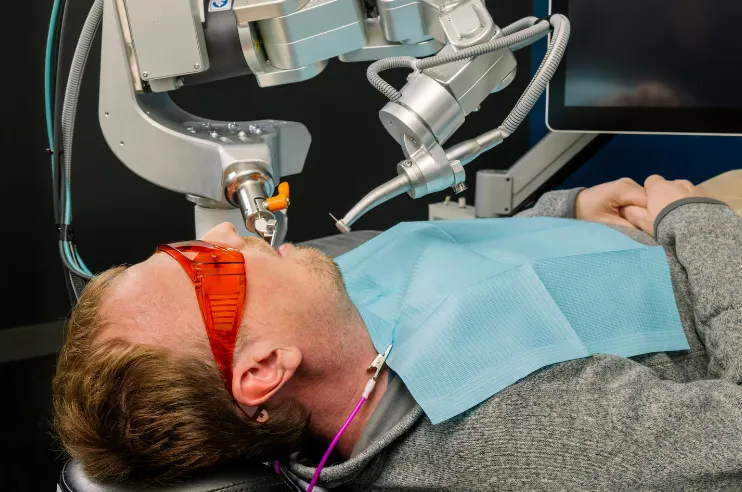
According to reports, the system was developed by Boston-based Perceptive, which utilized a handheld 3D volumetric scanner and optical coherence tomography (OCT) technology to create detailed 3D models of the mouth, teeth, gums, and even the dental pulp nerves. Compared to traditional X-rays, OCT uses light beams to construct high-resolution volumetric models and can automatically detect cavities with an accuracy of up to 90%.
After this step, human dentists and patients can discuss treatment plans. Once the treatment plan is determined, the robotic dentist takes over, planning and executing the surgery automatically.
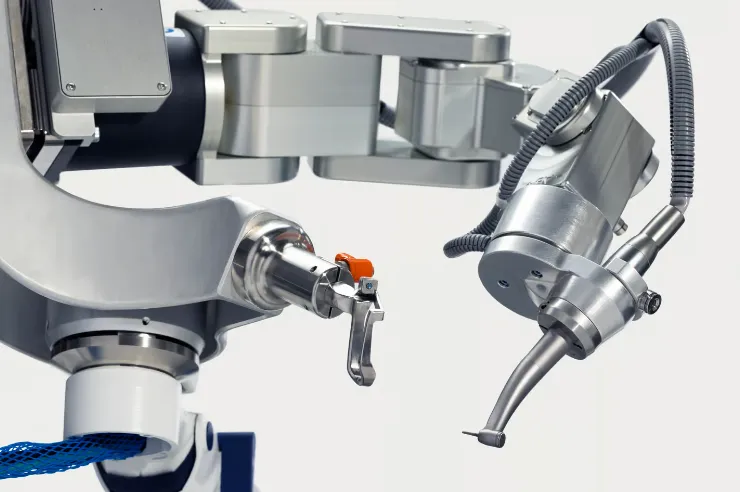
Surprisingly, the company claims that the robot can operate safely even when patients move significantly, and tests on moving human bodies have been successful.
Dr. Chris Ciriello, CEO and founder of Perceptive, stated: “We are thrilled to have successfully completed the world’s first fully automated robotic dental surgery. This medical breakthrough enhances the precision and efficiency of dental procedures, allowing more people to receive better dental care and improving patient experiences and clinical outcomes.”
This robotic dentist clearly has advantages, not only significantly reducing treatment time but also alleviating patient fatigue since they do not have to keep their mouths open for extended periods. Although the system itself may be costly, the time saved could lower overall treatment costs.
While the idea of sitting in a chair while a robot drills your teeth may be unsettling, it might not be as terrifying as it seems compared to human dentists. With the continuous advancement of robotic surgical technology and the gradual maturity of remote-operated robots, it may only be a matter of time before robots operate independently. However, the robot has not yet received FDA approval, and the specific market launch date is still uncertain, so the public may have to wait several years to experience this treatment. Perceptive has stated that it will continue to develop and expand the robot’s functions and treatment scope.
Is AI Robotics the Trend in the Industry?
Coincidentally, in June of this year, Professor Su Yuxiong and Dr. Pu Jingya from the University of Hong Kong’s Faculty of Dentistry performed a “special” surgery at Queen Mary Hospital in Hong Kong—the “world’s first” oral and maxillofacial reconstructive surgery driven by a medical multimodal large model.
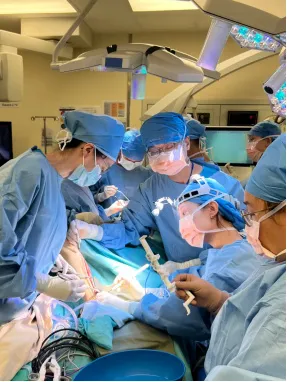
Professor Su Yuxiong’s team is performing the surgery
This surgery aimed to help a patient who lost one side of their mandible due to a tumor reconstruct their jawbone to restore normal oral and maxillofacial function. The procedure required transplanting the patient’s fibula and skin and soft tissue from the lower limb into the oral cavity to replace the missing mandible and soft tissue.
One of the key operations for the successful implementation of such surgeries is the precise localization and extraction of perforating blood vessels within the patient’s lower limb soft tissue. Traditionally, only highly skilled and experienced doctors could achieve minimal error during localization, and the precision of localization is often limited by imaging techniques such as ultrasound, which are not sufficiently accurate; additionally, doctors need to expend significant effort comparing ultrasound images with manual sketches of the surgical site.
However, this time, Professor Su’s team innovatively used the United Imaging Intelligent Multimodal Surgical Treatment Platform uAI MERITS to address the clinical pain points of relying on experience and intuition to locate perforating blood vessels in traditional oral and maxillofacial reconstructive surgeries.
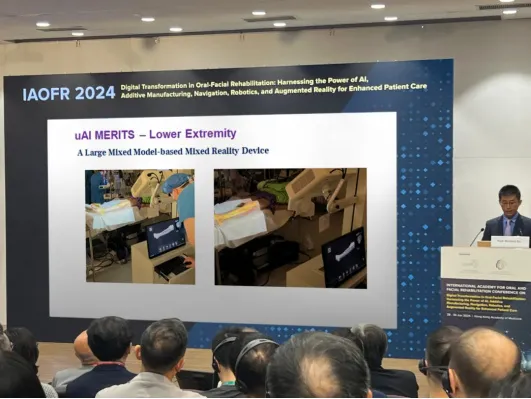
Professor Su Yuxiong shares the latest practices of uAI MERITS
The United Imaging Intelligent Multimodal Surgical Treatment Platform uAI MERITS is a metaverse ecosystem for robotic intervention, treatment, and surgery. It relies on medical multimodal large model technology to create digital twins of patients, medical personnel, and the operating environment in surgical scenarios, providing comprehensive intelligent support for preoperative preparation, intraoperative navigation, and postoperative follow-up.
The surgical plan was achieved by using a Transformer model trained on various medical images for precise segmentation preoperatively; intraoperatively, a multimodal large model was used to achieve registration of 3D images and videos, perspective projection, and dynamic visual tracking, providing real-time guidance during the procedure, significantly enhancing surgical efficiency and precision.
Additionally, on June 7, it was reported that the Affiliated Stomatological Hospital of Chongqing Medical University successfully performed the first robot-assisted surgery in the country.
This indicates that AI technology has deeply penetrated the core business of the dental industry and has already achieved good results and outcomes.
So, is the entry of AI technology into the dental industry truly beneficial with no drawbacks?
Not necessarily.
Impact of AI Technology on the Dental Industry
From a dialectical perspective, the entry of AI technology into the dental industry certainly has positive effects.
It is evident that AI robots can help dental clinics reduce workloads.
During the summer dental peak, on July 27, Caixin reported that many dental clinics experienced a surge in business, with some doctors working over three hours of overtime daily. In addition to traditional popular services like pediatric dentistry and orthodontics, whitening and other consumer-oriented services have also become quite popular; due to a shortage of manpower, dental services in Hong Kong have become difficult to obtain, prompting the recent introduction of a dental amendment allowing non-locally trained dentists to practice, which legislators claim will alleviate the industry’s manpower shortage.
If AI robotic technology is popularized across upstream and downstream clinics, it will undoubtedly help clinic doctors and medical staff reduce many simple yet tedious and repetitive tasks, greatly improving the reception efficiency of clinics. It could also reduce personnel expenses to some extent, thereby affecting consultation prices, potentially achieving similar effects to the centralized procurement of dental implants, lowering unit prices and increasing customer volume, which would have a positive impact on both clinics and patients.
Some netizens have also expressed their expectations for robots entering the dental industry.
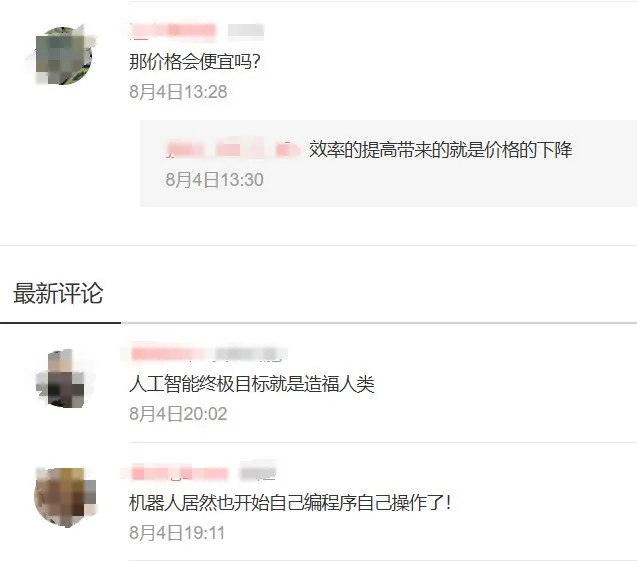
Moreover, compared to manual treatment, robotic treatment offers higher stability. The human body is not a machine; during prolonged work, precision and completion can be relatively affected, leading to risks during diagnosis and surgery. Robotic surgery is not subject to such influences, or the probability of such influences is significantly lower than that of human operations.
Of course, AI technology is not without its flaws.
Even the most precise instruments can make mistakes. The AI industry has been around for some time, yet certain sectors still use non-automated mechanical facilities. For example, almost all aircraft cabin doors are operated manually to prevent mechanical automation failures from exacerbating accidents.
In dentistry, if a dental robot malfunctions during a procedure, the potential harm could be significantly greater than that of a human operation. Even if no particularly severe harm occurs, the issue of how to allocate compensation afterward is also a challenging problem. Recently, there have been several incidents of disputes over medical compensation: on July 30, a woman in Beijing had her front tooth broken during a dental cleaning due to a falling instrument, and the parties could not reach an agreement on compensation after multiple discussions; on July 23, a man in Hunan had a syringe fall into his cavity during treatment, leading to pus formation, and the clinic suspected the man’s diagnosis record was fabricated, requiring court identification for prosecution.
If it is so difficult to allocate responsibility for accidents between people, who will bear the responsibility for accidents caused by machines? This is a question worth pondering.
Some netizens have expressed concerns about robots taking over dental jobs.

In addition to accident compensation, the entry of robots into the industry may also impact the employment landscape for dentists and medical staff. From basic repetitive tasks like reception, assistance, and nursing to participation in dental surgeries, the employment opportunities for dental workers in various fields may be compressed. The dental industry may no longer be viewed as a “golden bowl” by the public.
The Foundation of Dental Robots on Excellent Dentists
Due to technological limitations, the operational principles of current dental robots on the market are all based on the assistance of experienced dental professionals in programming. The operational principles of dental robots rely on the accumulated experience of these excellent dentists over many years. As of now, there are no dental robots capable of self-learning or self-adjusting their programs; without the assistance of these excellent dentists, dental robots cannot operate normally. In other words, current dental practices still cannot detach from human factors, and the surgical outcomes of dental robots can only achieve results comparable to or on par with human operations, but cannot surpass them.
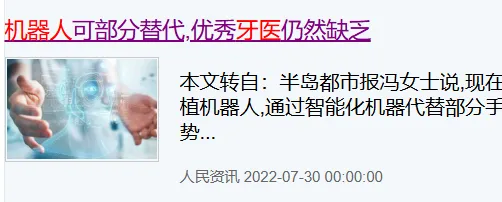
The Peninsula Urban Daily once published an article stating, “Robots can partially replace, but excellent dentists are still lacking.”
The article mentioned, “From existing cases, it is indeed true that robots have their advantages, being more precise and stable, and will certainly bring a certain impact to their industry. Especially for institutions with financial strength, they will definitely be the first to use these devices, which will certainly affect small dental clinics. Wang Yuming stated that dental implants are a complex procedure that is difficult to standardize into a production line operation. If the situation is simple, robots can perform the operation. However, the entire operational process requires doctors to make preliminary judgments, set the program, and input the corresponding data for the robot to complete the surgical steps. During the procedure, doctors also need to monitor the data in real-time. If data errors or circuit interruptions occur, the consequences without a doctor to intervene could be unimaginable. On the other hand, for some complex cases, implant robots still find it challenging to resolve. Each person’s bone condition is different, and some require bone grafting, which is difficult to accomplish through robots. “Currently, robots can moderately participate in the implant process, shortening the doctor’s working time, which also enhances the efficiency of the doctor’s implants and reduces labor costs to some extent. However, relying on them to completely replace human labor may still require a longer time to develop. Wang Yuming stated that compared to implant robots, excellent dentists remain indispensable, and increasing training efforts to enhance dentists’ skills is essential to fundamentally solve the problem.”
From the above information, it is clear that current dental AI robots have a long way to go before they can operate independently without human intervention and completely replace dentists. Perhaps one day in the future, we may see self-service dental clinics?
/ END /
丨This article’s material comes from the internet

